
![]()
Search the Journey to Forever website – click HERE
|
Journey to Forever: Make a donation |
Navigation
| Small farms library | |
| City farms | |
| Organic gardening | |
| Composting | |
| Small farms | |
| Introduction Sustainable farming Small farms fit References |
|
| Small farm resources | |
| Back to the land | |
| Small farms | |
| Organics | |
| Soil management | |
| Sustainable farming | |
| General resources | |
| Food storage and preservation | |
| Useful databases | |
| Community-supported farms | |
| Farming with trees | |
| Agroforestry Bamboo Resources |
|
| Farming with animals | |
| Introduction Livestock resources Cattle Sheep General Draft animals |
|
| Pasture | |
| Introduction Pasture resources Silage |
|
| Pigs for small farms | |
| Why pigs have snouts Raising pigs on soil in Japan Lady Eve's pigs Pigs on pasture Pig resources |
|
| Poultry for small farms | |
| Muscovy ducks Khaki Campbell ducks Chickens Geese Rabbits Guineafowl General tips High-protein poultry feed from thin air Poultry as unpaid labour They're not pets Doing it |
|
| Poultry resources | |
| Aquaculture for small farms | |
| Introduction Aquaculture resources |
|
| Composting for small farms | |
| Foundation On-farm composting resources |
|
| Controlling weeds and pests | |
| Weeds Weed control resources Insect pests No pesticides Insect control resources |
|
Contact usTo Keith Addison Handmade Projects |
Controlling weeds and pests
"Pests do not arise because of a deficiency of pesticide in the environment any more than headaches result from a lack of aspirin in the blood stream. We get headaches because of the way we conduct our lives, and we get pests in the fields because of the way we manage them."
-- S.B. Hill and J.A. Ramsay. 1977, Limitations of the energy approach in defining priorities in agriculture (in Lockeretz, W. (ed.) Energy in Agriculture), full text online:
http://eap.mcgill.ca/Publications/EAP18.htm
"Even with the 10-fold increase in insecticide use in the United States from 1945 to 1989, total crop losses from insect damage have nearly doubled from 7% to 13%". -- David Pimentel, Professor of Insect Ecology and Agricultural Sciences at Cornell University
Weeds
Weed control resources
Insect pests
No pesticides
How to kill pests without killing yourself or the earth
Insect control resources
Weeds
What are weeds? There are lots of vehement definitions -- they're pests, enemies, they're noxious, evil and treacherous, or so gardeners and farmers say. The biosphere's view, which might be more important, is that gardeners and farmers who fight weeds are the enemy because they damage the soil. Weeds are the frontline troops nature uses to repair damaged soil. If you don't want to fight weeds then don't damage the soil.
"Weeds are evidence of nature struggling to bring about natural succession," says Preston G. Sullivan, Technical Specialist with the Appropriate Technology Transfer for Rural Areas (ATTRA) in Principles of Weed Management for Croplands. "When we clear native vegetation and establish annual crops, we defy ecological succession. Man is, in effect, holding back natural plant succession, at great cost in weed control."
Sullivan says the answer is more biodiversity: "Stability through biodiversity is one of nature's fundamental rules."
In effect, the weeds are trying to turn your land back into a forest.
"What are the main principles underlying Nature's agriculture? These can most easily be seen in operation in our woods and forests. Mixed farming is the rule: plants are always found with animals: many species of plants and of animals all live together." (From Chapter 1, Introduction, "An Agricultural Testament", by Sir Albert Howard)
Increased biodiversity and good soil fertility maintenance solve weed problems. Some weeds grow to cover an exposed soil that's vulnerable to erosion and run-off -- nature hates exposed soil. So cover it yourself, with a mulch, or better, with a "living mulch" composed of a diversity of close-planted crops. Other weeds are deep-rooting plants that go down to the subsoil to collect fresh minerals when the topsoil runs out of them. Composting will maintain topsoil minerals. It's also a good idea to leave some of them growing -- they're good "companion plants" for your crops and they're good for the soil.
"We have seen some dramatic shifts/reductions in weed populations as soil has been under organic management longer and as fertility problems are corrected.
"For instance, quackgrass and nutsedge have all but disappeared from our fields in the past 5 years as we've been farming organically and been paying close attention to soil fertility balance. They are still present in thin patches when we plow, but with so little vigor that they don't show in the crop afterwards.
"Other whole classes of weeds, such as summer annual grasses like foxtail, panicum, and barnyard grass, have also disappeared.
"Some of the weeds, such as velvetleaf (buttonweed) and lambsquarters, while still present are growing with greatly reduced vigor and smaller populations." -- Organic farmer Klaas Martens, USA
"Most of the plants that I call weeds are involved in the primary stages of natural succession," writes Kim Wilkinson in AgroForester. "They are medicine for the soil, repairing it and revitalizing life. Succeeding weeds is about stepping-up the process of succession. Weeds are experts in the process of succession, and great soil indicators as well, so I always look to them to learn what is appropriate. This means mulching and filling the space with appropriate plants (groundcovers, crop trees and other vegetation), creating a healthy system with no room and no need for voracious weeds to modify it. Some of the most aggressive weeds need full sun and low fertility to thrive; by increasing shade, organic matter and soil health they will disappear." ("Working with Weeds in the Tropics -- If You Can't Eat Them, Succeed Them!")
http://www.agroforester.com/articles/Working_with_Weeds.html
Striga -- witchweed -- is one of the worst weeds in the world. It's a parasitic weed of cereal crops and it can cost subsistence farmers in Africa two-thirds of their crops. Striga roots invade the roots of cereal plants and consume the host plant's sap. By the time the flowers appear, it's already too late: the damage is done. Each striga plant yields thousands of seeds, which survive in the soil for up to 20 years.
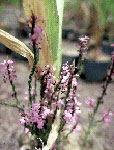
Striga kills cereals
Biological controls are now being used, but striga is basically the same as other weeds, and the same rules apply: "Striga thrives under conditions of low soil fertility and decreasing plant diversity." (ECHO Development Notes, Issue 59, February 1998)
"Experiments in western Kenya show enormous potential for some common weeds to increase soil fertility in cropland. Fast growing weeds that produce a lot of biomass are collected both on- and off-farm and used as green manure. Compared to commercial fertilizers, application of high amounts of Tithonia or Lantana green manure had very good results on growth and yield of maize. An additional benefit of the green manure was a significant reduction of the presence of the parasitic weed Striga (by almost 70%)" -- Rik Thijssen, "Weeds and trees", ILEIA Newsletter Vol. 11 No. 3 (October 1995): "We Love Weeds".
"The best way to dispose of a weed is to make use of it, to promote it to the level of wanted plants," says Thijssen. Some Third World farmers simply wouldn't survive without their "weeds"! Thijssen's article explains why:
http://www.oneworld.org/ileia/newsletters/11-3/11-3-20.htm
"It is not unusual for one plant thus to prey on another, which, we may be sure, invites the enemy only because it is starved or in some way weakened. The Indian cultivator knows this and at once supplies manure if he finds his sugar cane preyed upon by a species of Striga; the Striga disappears... The best proof has been established by some formal experiments carried out in South Africa on witch-weed (Striga lutea), which constantly and severely infects the maize crop; dressings of humus at the rate of ten tons to the acre proved a complete cure, and the disease-free crop formed an excellent contrast to the control plot alongside, which was a red carpet of the weed. (Experiments of Mr. Timson reported to The Rhodesia Agricultural Journal, October 1938, and confirmed by official experiments at the Rhodesian Witch-weed Experimental Farm: see An Agricultural Testament, Ch. 5 and Compost News Letter, No. 5, pp. 17-18.)" -- The Earth's Green Carpet by Louise E. Howard, 1947, Faber & Faber, London: Chapter 9. Disease as Censor. Full text online at the Small Farms Library.
"... Striga, a parasitic plant that wrecks $10 billion worth of maize crops every year, threatening the livelihoods of 100 million Africans. Weeding Striga is one of the most time-consuming activities for millions of African women farmers, says Ziadin Khan, of the International Centre for Insect Physiology and Ecology in Nairobi. But he has an antidote: another weed, called Desmodium. "It seems to release some sort of chemical that Striga doesn't like. At any rate, where farmers plant Desmodium between rows of maize, Striga won't grow." Khan's cheap fixes are spreading like wildfire through the fields of east Africa. Trials on more than two thousand farms are finished." -- "An Ordinary Miracle", New Scientist, February 3, 2001
See also:
Quack grass
What are weeds? -- Water hyacinth and duckweed
Weed control resources
Principles of Weed Management for Croplands -- Agronomy Systems Guide, by Appropriate Technology Transfer for Rural Areas (ATTRA). "Weeds are invited guests into agricultural fields as the result of management decisions and defying nature's principles. Managing croplands in tune with nature's principles makes for fewer and less costly weed problems. Strategies which utilize allelopathy, intercropping, crop rotations reduce weeds considerably." A weed-free design, other weed control strategies. About 8,000 words. "First, Free Your Brain".
http://www.attra.org/attra-pub/weed.html
Insects and Weeds on the Web -- many resources with information on biological controls and how to control pests and weeds organically, at the Don't Panic Eat Organic site.
http://www.rain.org/~sals/bugs.html
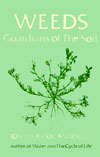 "Weeds -- Guardians of the Soil" by Joseph A. Cocannouer, Devin-Adair, 1950.
"Weeds -- Guardians of the Soil" by Joseph A. Cocannouer, Devin-Adair, 1950.
Professor Cocannouer, who taught biology and conservation for 50 years, demonstrates how the controlled use of weeds is sound ecology, good conservation and a boon to the gardener. Weeds as indicators of soil conditions, weeds as companion plants.
Full text online at the Small Farms Library
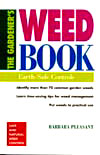 "The Gardener's Weed Book: Earth-Safe Controls" by Barbara Pleasant, 1996, Storey Books, ISBN 0882669214
"The Gardener's Weed Book: Earth-Safe Controls" by Barbara Pleasant, 1996, Storey Books, ISBN 0882669214
Safe and natural weed control. Identifies more than 70 common garden weeds, with tips for weed management and putting weeds to use. Weeds, grassy weeds, vining weeds, family relations. From Powell's Books:
http://www.powells.com/biblio/
61-9780882669212-0
"Future Harvest: Pesticide-Free Farming" (Our Sustainable Future, Vol 5) by Jim Bender, 1994, Univ of Nebraska Press, ISBN 080321233X
"For me, one of the sweetest moments of my life came in 1980, when I eliminated all pesticide use on my field crops, thereby successfully matching my practice with my convictions." Bender converted his 642-acre Nebraska farm to organic production over a decade. He says chemical farming damages the water supply and that applying herbicides to soybeans actually encourages weeds. He makes a persuasive case for organic methods: modern organic farming makes good use of modern technology and is not a step back to a century ago. Bender dismisses charges that alternative agriculture is less productive, and if it's more labor-intensive, it's because of the necessity to include livestock (and manure production) in the operation. From University of Nebraska Press:
http://unp.unl.edu/bookinfo/2596.html
Insect pests
-- "Pesticides are the badge of the amateur" -- an organic grower
"The pests are my professors," wrote Sir Albert Howard, founding father of the organics movement. Pest attack showed him where the soil fertility needed attention. Plants growing in fertile soil have healthy immune systems and can repel pest attack. Where this doesn't happen, the soil is unbalanced. Correcting the problem restores plant health and the pests depart.
Using poison sprays is futile, and worse: the poisons also kill beneficial insects which naturally control the pests. Most of today's major crop pests have actually been caused by pesticides which have wiped out their natural predators.
Scientists at the University of Georgia found that plants send out specific signals for parasitic wasps to come to their aid when under attack by plant-eating insects. Parasitic wasps are the natural enemies of some of the pests. The scientists used cotton, tobacco and maize plants, all of which emitted the signals for the wasps. Each species of wasp is only parasitic on certain pest species. The signal sent out by the plants attracted the very species of wasp that parasitizes the attacking pests. (ECHO Development Notes, Issue 66, December 1999)
Eve Balfour, one of the founders of the organics movement, told how a commercial organic grower was visited by a team of plant pathologists and entomologists from Cambridge University. "They knew it was an unsprayed holding and they came looking for disease and pests. They found isolated examples of everything they expected to find, but, as they put it, they failed to find a single case of crop damage." -- Lady Eve Balfour, Towards a Sustainable Agriculture -- The Living Soil, an address to an IFOAM (International Federation of Organic Agriculture Movements) conference in Switzerland in 1977. Online at the Small Farms Library.
No pesticides
Rotenone is a safe and effective organic insecticide (biocide, pesticide) derived from derris roots, used by traditional societies in the east for centuries and approved for use by all organic associations. The effects are not persistent, it is biodegradeable and breaks down quickly into harmless by-products, and it is harmless to birds and mammals.
But most organic growers don't use it: less than 6% of the respondents to a US Department of Agriculture survey of certified organic vegetable growers reported using rotenone (American Journal of Alternative Agriculture, Vol. 13, No. 2, 1998).
"I don't think we are unique among experienced organic growers in using very little intervention in pest management." (Organic grower, US)
"I, too, use no biocides. People who think you have to use biocides to farm assume incorrectly that organic farmers use botanical biocides. This is not the case. Very few organic farmers merely switch from synthetic to organic biocides. For some this may be a first step in the transition to organic growing, but it is not the rule.
"Organic farmers have shown that food crops can be grown with the same or more production per acre, with the same or less lost to pests, without using biocides or NPK (chemical) fertilizers)." (Organic grower, US)
How to kill pests without killing yourself or the earth
Email message to Journey to Forever from Stephen L. Tvedten, author of "The Best Control" Integrated Pest Management encyclopedia, 11 Mar 2007
There are about 50 to 60 million insect species on earth -- we have named only about 1 million and there are only about 1 thousand pest species -- already over 50% of these thousand pests are already resistant to our volatile, dangerous, synthetic pesticide poisons. We accidentally lose about 25,000 to 100,000 species of insects, plants and animals every year due to 'man's footprint'. But, after poisoning the entire world and contaminating every living thing for over 60 years with these dangerous and ineffective pesticide poisons we have not even controlled much less eliminated even one pest species and every year we use/misuse more and more pesticide POISONS to try to 'keep up'! Even with all of this expensive pollution -- we lose more and more crops and lives to these thousand pests every year.
We are losing the war against these thousand pests mainly because we insist on using only synthetic pesticide poisons and fertilizers There has been a severe 'knowledge drought' -- a worldwide decline in agricultural R&D, especially in production research and safe, more effective pest control since the advent of synthetic pesticide poisons and fertilizers. Today we are like lemmings running to the sea insisting that is the 'right way'. The greatest challenge facing humanity this century is the necessity for us to double our global food production with less land, less water, less nutrients, less science, frequent droughts, more and more contamination and ever-increasing pest damage.
In order to try to help 'stem the tide', I have just finished re-writing my IPM encyclopedia, The Best Control II, which contains over 2,800 safe and far more effective alternatives to pesticide poisons. This latest copyrighted work is about 1,800 pages in length and is now being updated chapter by chapter at my new website (see below).
This new website has all of my original IPM encyclopedia in its original form and will continue to have more and more free, updated Chapters every week. So far we have electronically updated The Introduction, Chapter 11, 15, 16A, 16B, 17, 18, 19, 20, 21, 22, 23, 24, 25, 26, and the Glossary of Terms. All of these copyrighted items are free for you to read and/or download. There is simply no need to POISON yourself or your family or to have any pest problems.
Stephen L. Tvedten
Marne
Michigan
USA
Insect control resources
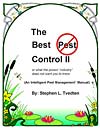 The Best Control II by Stephen L. Tvedten -- Integrated Pest Management encyclopedia of safe insect controls. "Learn how to practice nontoxic pest control using safe alternatives to pesticides. This book is offered free of charge to encourage the spread of nontoxic pest control. All chapters are available (in PDF format) for download." 40 chapters, 1,800 pages covering the entire subject, updated regularly, full text free online.
The Best Control II by Stephen L. Tvedten -- Integrated Pest Management encyclopedia of safe insect controls. "Learn how to practice nontoxic pest control using safe alternatives to pesticides. This book is offered free of charge to encourage the spread of nontoxic pest control. All chapters are available (in PDF format) for download." 40 chapters, 1,800 pages covering the entire subject, updated regularly, full text free online.
http://www.stephentvedten.com/
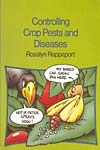 "Controlling Crop Pests and Diseases", Rosalyn Rappaport, Practical Action; New Edition (1999), ISBN 9781853396007
"Controlling Crop Pests and Diseases", Rosalyn Rappaport, Practical Action; New Edition (1999), ISBN 9781853396007
Covers pest and disease damage, causative agents, and methods of combatting them. As well as manual and cultural techniques, it shows that expensive chemicals are not necessary -- the secrets of cheaply-available or improvised ingredients are revealed. Also covers protection against larger animals and wind, using hedges and ditches. The examples are illustrated stories presented as strip cartoons for extension staff or teachers to show and hand out to farmers and students. From the Development Bookshop:
http://developmentbookshop.com/product_info.
php?manufacturers_id=&products_id=682
 "The Gardener's Bug Book: Earth-Safe Insect Control" by Barbara Pleasant, revised edition 1994, Storey Books, ISBN 0882666096
"The Gardener's Bug Book: Earth-Safe Insect Control" by Barbara Pleasant, revised edition 1994, Storey Books, ISBN 0882666096
This is an updated version of The Bug Book, written by organics specialists Helen and John Philbrick in 1974. Covers beneficial insects, formulas for organic controls and over 70 common insect pests. How to work with nature to reduce pests while producing bountiful, environmentally safe and chemical-free harvests. The challenge is "To try to synthesize nature's kingdom". From Powell's Books:
http://www.powells.com/biblio/6-9780882666099-2
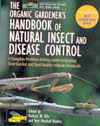 "The Organic Gardener's Handbook of Natural Insect and Disease Control" by Barbara W. Ellis & Fern Marshall Bradley, editors, Revised edition 1996, Rodale, ISBN 0875967531
"The Organic Gardener's Handbook of Natural Insect and Disease Control" by Barbara W. Ellis & Fern Marshall Bradley, editors, Revised edition 1996, Rodale, ISBN 0875967531
Complete guide to pest and disease control without chemicals. Problem-solving diagnostic encyclopaedia covers more than 200 plants. Over 350 color photos for quick identification of pests, beneficial insects and plant diseases. From Powell's Books:
http://www.powells.com/biblio/0875967531
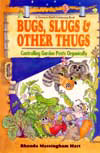 "Bugs, Slugs & Other Thugs: Controlling Garden Pests Organically" by Rhonda Massingham Hart, 1991, Storey Books, ISBN 0882666649
"Bugs, Slugs & Other Thugs: Controlling Garden Pests Organically" by Rhonda Massingham Hart, 1991, Storey Books, ISBN 0882666649
Help in identifying pests and a host of practical, safe solutions, ranging from the latest scientific advances to old folk remedies that really work. "Forced to adapt in the face of chemical attacks, insects mutated and survived. They developed resistance to pesticides, making it necessary to apply more and stronger chemicals, with ever more severe consequences. With their natural enemies exterminated, insects that had rarely caused problems in the past suddenly reached outbreak proportions. Clearly, it's time to seek alternatives to pesticides." Thorough treatment. From Powell's Books:
http://www.powells.com/biblio/6-9780882666648-2
 "Natural Insect Control: The Ecological Gardener's Guide to Foiling Pests", Warren Schultz (Editor), 1995, Brooklyn Botanic Garden, ISBN 0945352832
"Natural Insect Control: The Ecological Gardener's Guide to Foiling Pests", Warren Schultz (Editor), 1995, Brooklyn Botanic Garden, ISBN 0945352832
Pick a pest, and you can almost surely find a natural control for it -- one that won't poison you, your kids or your pets, won't cause cancer and won't wreak ecological havoc. This handy guide is designed to make natural, non-toxic pest control as easy as possible. From Alibris:
http://www.alibris.com/booksearch?
title=%22Natural+Insect+Control%22
Small farms
Small farm resources
Community-supported farms
Farming with trees
Farming with animals
Pasture
Pigs for small farms
Poultry for small farms
Aquaculture for small farms
Composting for small farms
Controlling weeds and pests
Small farms library
City farms
Organic gardening
Building a square foot garden
Plant spacing guides
No ground? Use containers
When to sow what
Seeds
Garden pond
Gardening resources
Composting
Making compost
Composting resources
Composting indoors
Vermicomposting
Humanure
Composting for small farms